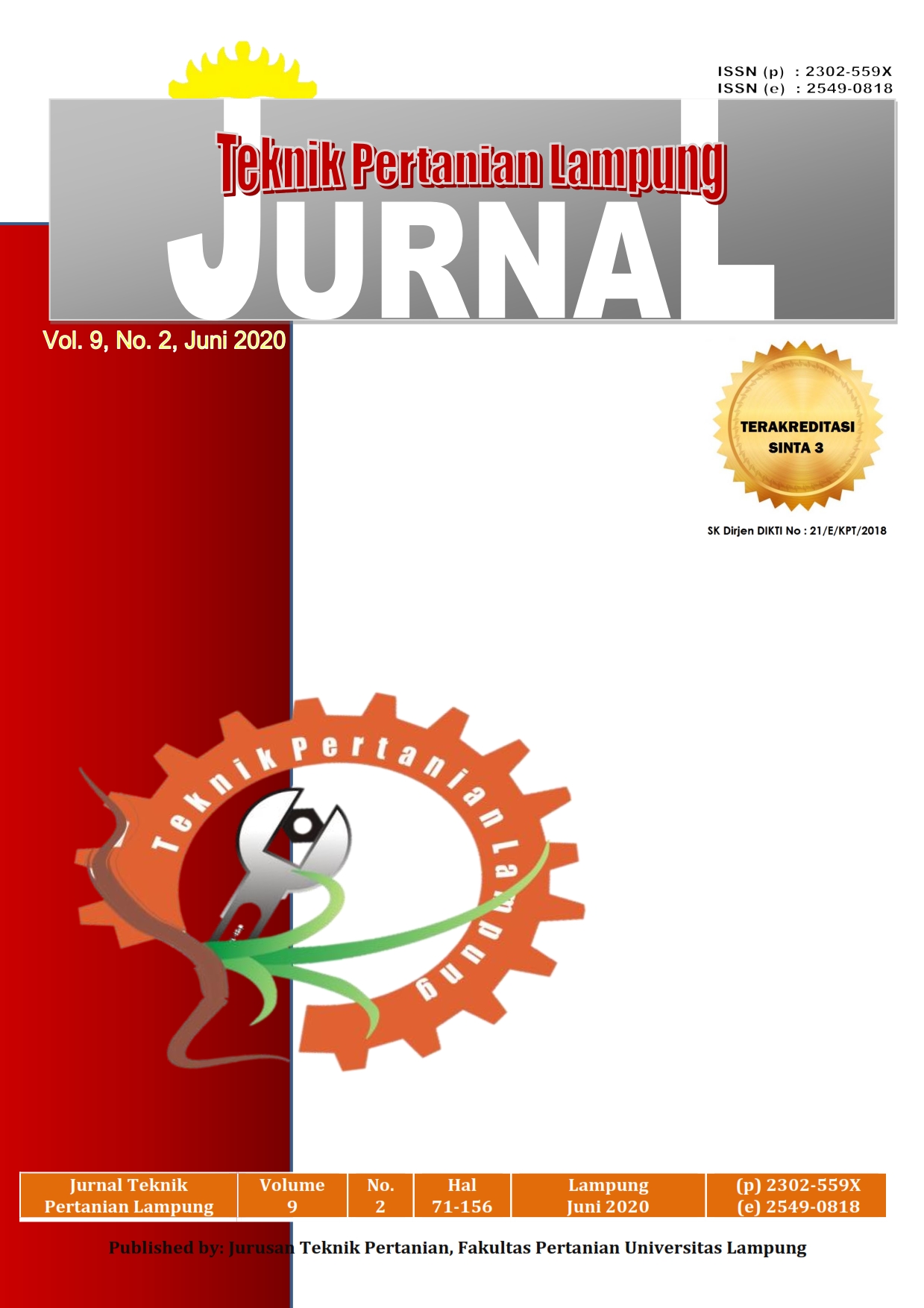PEMETAAN LAHAN PERTANIAN DI KABUPATEN LOMBOK TIMUR MENGGUNAKAN SISTEM INFORMASI GEOGRAFIS (SIG)
DOI:
https://doi.org/10.23960/jtep-l.v9i2.140-148Abstract
This study aimed to analyze and to map the ability of agricultural land in East Lombok Regency West Nusa Tenggara Province using Geographic Information System (GIS). The method used in this research is descriptive to analyze and match data on the condition of the study area with the criteria for land capability class refer to the Minister of Environment Regulation No.17 of 2009. The parameters observed were soil texture, slope, drainage, effective depth, erosion, and flood threat. The results showed that East Lombok Regency was included in 6th land capability classes, namely class II, III, IV, VI, VII and VIII. Land with class IV dominates the research area is 501.04 km2 which is spread almost in all districts in East Lombok Regency. Areas with class II, III, and IV land are the land that can be used for agricultural cultivation, while class VI, VII, and VIII land is the land with heavy inhibitor factors, so it is better left in natural conditions.
References
Adnyana IWS. dan Asy-Syakur A R. 2012. Aplikasi SIG berbasis data raster untuk pengkelasan kemampuan lahan di Provinsi Bali dengan metode nilai piksel Pembeda. Jurnal Manusia dan Lingkungan, 19(1): 45-53.
Ansar, Putra GMD, dan Opan S E. 2019. Analisis variasi jenis dan panjang sumbu terhadap pertumbuhan tanaman pada sistem hidroponik. Jurnal Ilmiah Rekayasa Pertanian dan Biosistem, 7(2): 166-173. Doi: 10.29303/jrpb.v7i2.124.
Aulia S. Ansar, dan Putra GMD. 2019. Pengaruh intensitas cahaya lampu dan lama penyinaran terhadap pertumbuhan tanaman kangkung (ipomea reptans poir) pada sistem hidroponik indoor. Jurnal Ilmiah Rekayasa Pertanian dan Biosistem, 7(2): 44-52. Doi: 10.29303/jrpb.v7i1.100.
Arsyad S. 2010. Konservasi Tanah dan Air. Edisi Kedua. Serial Pustaka IPB Press. Bogor.
Asdak C. 1995. Hidrologi dan Pengelolaan Daerah Aliran Sungai. Gadjah Mada University Press. Yogyakarta.
Baja dan Sumbangan. 2012. Perenca-naan Tata Guna Lahan Pengembangan Wilayah. Andi Offset. Yogyakarta.
Foth H D. 1994. Dasar-dasar Ilmu Tanah. Terjemahan S. Adisumarto. Edisi Keenam. Erlangga. Jakarta.
Hadmoko D S. 2012. Evaluasi Sumber Daya Lahan Prosedur dan Teknik Evaluasi Lahan: Aplikasi teknik scoring dan matching. Universitas Gajah Mada. Yogyakarta.
Harahap M E. 2007. Peranan tanaman kelapa sawit pada konservasi tanah dan air. Skripsi, Fakultas Pertanian Universitas Sumatera Utara. Sumatera.
Hardjowigeno, S dan Widiatmaka. 2007. Evaluasi Kesesuaian Lahan dan Perencanaan Tata Guna Lahan. Gadjah Mada University Press. Yogyakarta.
Irawan. 2005. National Rice Availability Analysis: A Simulation Study of System Dynamics Approach. Multi-function Agriculture Proceedings.
Irwansyah E. 2013. Sistem Informasi Geografis: Prinsip Dasar dan Pengembangan Aplikasi. Penerbit Digibooks. Yogyakarta.
Kartasapoetra A G. 1990. Kerusakan Tanah Pertanian dan Usaha untuk Merehabilitasinya. Bumi Aksara. Jakarta.
Mufidah R. Basofi A. dan Farizza A. 2011. Sistem Informasi Geografis (SIG) Pemetaan Lahan Pertanian di Wilayah Mojokerto. Skripsi, Fakultas Teknik, Politeknik Elektronika Negeri, Surabaya.
Notohadiprawiro T. 1999. Tanah dan Lingkungan. Direktorat Jenderal Pendidikan Tinggi Departemen Pendidikan dan Kebudayaan. Jakarta.
Rastuti A. dan Agustini E P. 2015. Sistem Informasi Geografis Potensi Wilayah Kabupaten Banyuasin Berbasis Web. CS-SITI2015. Universitas Bina Darma.
Romadhon, Agus, dan Sucipto. 2010. Pemetaan potensi komoditas dan rancangan pengembangan di Kecamatan Blega, Bangkalan Madura. Jurnal Agrovigor, 3(2): 146-156.
Sutanto R. 2005. Dasar-dasar Ilmu Tanah, Konsep dan Kenyataan. Penerbit Kanisius. Yogyakarta.
Suyana, Jaka, Muliawati, dan Endang S. 2014. Analisis kemampuan lahan pada sistem pertanian di Sub-DAS Serang Daerah Tangkapan Waduk Kedung Ombo. Jurnal Ilmu Tanah dan Agroklimatologi, 11(2): 132-140.
Wahyuningrum N. Nugroho W B. Endang S. dan Sudirman. 2003. Klasifikasi kemampuan dan kesesuaian lahan. Info DAS Surakarta No. 15 Th. 2003.
Downloads
Published
Issue
Section
License
- Authors who publish with this journal agree to the following terms:
- Authors retain copyright and grant the journal right of first publication with the work simultaneously licensed under a Creative Commons Attribution-ShareAlike 4.0 International Lice that allows others to share the work with an acknowledgement of the work's authorship and initial publication in this journal.
- Authors are able to enter into separate, additional contractual arrangements for the non-exclusive distribution of the journal's published version of the work (e.g., post it to an institutional repository or publish it in a book), with an acknowledgement of its initial publication in this journal.
- Authors are permitted and encouraged to post their work online (e.g., in institutional repositories or on their website) prior to and during the submission process, as it can lead to productive exchanges, as well as earlier and greater citation of published work (See The Effect of Open Access).
Jurnal Teknik Pertanian Lampung

JTEPL is licensed under a Creative Commons Attribution-ShareAlike 4.0 International License.

